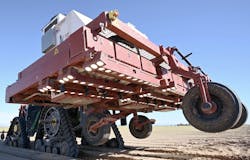The Vision of Sustainable Agriculture: Laser-Focused on a Weed-Free Farm
When it comes to sustainable agriculture, the challenge of finding effective weed management has led to some groundbreaking technologies. Carbon Robotics’ LaserWeeder stands out among them, using cutting-edge computer vision and artificial intelligence (AI) to address the never-ending need for weed control in agriculture.
Founded in 2018, the company began with a vision to integrate advanced technology with traditional farming methods. Paul Mikesell, CEO, brought with him expertise in AI and robotics, translating insights gained from discussions with farmers to actionable solutions. His goal was clear: Harness Silicon Valley innovation to tackle region-specific agriculture issues that have been overlooked through the years.
The Role of Technology in Sustainable Ag
At the heart of the laser weeding machine’s functionality is its sophisticated vision system. Using real-time data processing, the machine leverages deep learning models to distinguish between crops and weeds. This is accomplished through an array of cameras integrated with an AI-driven neural network, which continuously assesses its environment, making on-the-fly predictions and classifications.
READ MORE: Sustainable Agriculture: Weed-free Fields with Lasers
Unlike traditional object detection algorithms that rely on contours and edge detection, the LaserWeeder’s neural networks are designed to comprehend higher-level plant characteristics, allowing for adaptive responses to varying soil conditions and environmental factors.
The application of high-powered lasers for weed eradication offers a shift in agricultural practices. By targeting weeds directly and avoiding the need for herbicide usage, the machine eliminates the risks associated with chemical exposure for farmers and consumers alike. This method not only preserves the integrity of the crops but also minimizes environmental impact.
Mikesell highlights two primary benefits of the laser technology: enhancing crop yield and reducing dependency on fertilizers and water, as the plants experience less stress from chemical applications.
“It doesn’t knock your crops back, right, because if you’re not spraying herbicide, you’re not damaging your crops.” Mikesell said, noting that farmers also need less fertilizer and water to grow crops. He added that because blades are no longer being dragged to the ground, torn-up topsoil isn’t causing erosion.
System Performance and Real-World Challenges
Operational efficiency is built into the machine’s design. The LaserWeeder navigates fields at a rate of approximately 1 to 2 acres per hour, an effective speed for thoroughness that also can be adapted to the weed density in the fields. The effectiveness of the vision system is demonstrated through key performance indicators (KPIs), which aim for more than 90% accuracy in weed identification, while ensuring that crop misidentification remains below 1%.
Before bringing the machine to market, Carbon Robotics engaged in extensive field testing from 2018 to 2022. This phase revealed the many environmental challenges that agricultural robotics must overcome such as heat humidity and dust.
“By the time we had machines to market, we’d been through several different generations of [the] machine—everything from the type of optics and servos to the type of GPUs and the types of neural nets that we were using,” Mikesell said.
These rigorous field trials were important, he said, due to the unpredictable nature of outdoor conditions. The commitment to real-world application ensures that the laser reader performs consistently in a range of settings.
“I think people have a tendency to try stuff in the lab and then never get it into the field,” Miksell said.
ROI, Future Outlook and Scalability
From an economic perspective, the company aims for a return on investment (ROI) for farmers that allows for payback within one to three years of equipment purchase. Yield increases of up to 50% have been reported, which demonstrates the machine’s effectiveness for eliminating unwanted vegetation. By reducing herbicide reliance, farmers can gain insights into the extent of damage previously done to crops by chemical applications.
With regard to finding reliable suppliers for the integration of advanced components in the machine, Mikesell says that the company collaborates with several companies worldwide to ensure they source the best parts. This multi-sourcing strategy guarantees quality and reliability in the system’s components, he says.
As Carbon Robotics looks to the future, Mikesell says they are creating a new, unrelated product line that will be released later this year.
When asked if the Average Joe would have access to this type of weed eradicator for the backyard, Mikesell said, “[If somebody] wanted to produce a consumer version, we could maybe license some of the software or something, but that’s a different business than what we focus on,” he said. Carbon Robotics’ focus remains on business-to-business (B2B) solutions.
For now, the company is concentrated on refining its current LaserWeeder model while exploring potential expansions in equipment size and functionality in response to evolving agricultural needs, helping to provide a sustainable pathway toward the future of farming.



